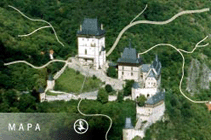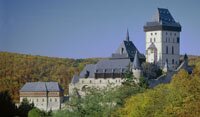Map:


History of the castle
It is very obvious that this majestic late-gothic castle was built by an orthodox Christian. Its gradual setting symbolizes The Holy mountain of Jerusalem with a temple on the top. The medieval cosmography considered Jerusalem the centre of the world. So Charles IV may have wanted Karlstejn to become the centre of the Holy Empire.
Treasury of the Holy Empire
The year 1348 is of great significance to Czech history. That year enters the chronicles as the time when Charles IV established The University of Prague, founded The New city of Prague and built Karlstejn. The foundation-stone was festively laid by the archbishop Arnošt of Pardubice on river bank of Berounka. Rumor has it that no building of any other castle was ever been commenced so solemnly. Again Karlstejn was no ordinary castle. It was build for an extraordinary reason, to be the treasury and stash of holy relics of the Holy Empire.
Pilgrimage to the symbols of eternal salvation
Karlstejn stands up on a rock being composed of many floors. The highest was the shelter for the treasure, or to be more specific the Chapel of St Cross in the Great tower was. If a pilgrim wished to see the treasure he had to pass through sanctuaries of the Emperor’s palace in the Mariánská tower. On the lowest floor of the castle we may find The Water well tower (Studniční věž) with apparently a well inside. However the most interesting thing about the well is that it is not really a water well. The miners of Kutná Hora dug almost 80 meters deep into the rock and found no water. So they connected the pit with a nearby stream and gathered the water in a tank. This was known only by the king and burgraves. Imagine this information falling into enemy hands in the time of the siege. There would be nothing easier than diverting the stream-bed, or so much more effectively poisoning it. It is said that for security reasons were all workers present at the construction of the channel beheaded.
Battles for crown jewels
Up until the year 1421 Karlstejn was inhabited by kings and so the castle flourished. For some time the imperial crown jewels were kept here along with the Czech ones. However the brother of Wenceslas IV – Sigmund had the Roman treasure transported abroad. The Czech crown followed in the beginning of the Thirty Years’ War. Later it showed that the fear for the security of the jewels was inadequate. The Hussites besieged all hills around Karlstejn, tossed stones onto its walls, as well as barrels with burning pitch or feces. However they never even got to the courtyard of the castle. The Swedish broke through the walls and got to the Great wall, however they didn’t conquer its fortifications. The decorations of the Chapel of St Cross suffered very badly because of defenders more than attackers. The soldiers stole many valuables to insure the income of supplies to the castle.
The Splendors and Miseries of the Karlštejn walls
Karlstejn was at the end of fifteenth century partially reconstructed in gothic style. This was later followed by renaissance decorations. However after the year 1619 (when Czech crown jewels were taken away) the castle began to decay. The treasure then traveled to Wien for it could later – in the year 1867 return to cathedral of St Vitus in Prague castle. This was the original storing place of the crown of St Wenceslas. The queen Eleanor pawned Karlstejn and in the second half of the seventeenth century some rooms of the castle were about to collapse. For some time there used to be granary and store room. The interest in this cultural inheritance came back in the era of Romantism.
Renaissance of the castle
At the end of the eighteenth century the fading castle began to impress artists with its mysterious aura. Maybe they were the reason why in the 1812 the emperor Franz I decided to visit the castle. However the great reconstruction began forty seven years later. It was led by Joseph Mocker who wanted to restore the original gothic outlook in a purist spirit. That meant eliminating all previous reconstructions and changeovers, even the good and successful ones. Karlstejn obtained new roofs which nowadays form its characteristic impression.
X41 | X-Yachts
